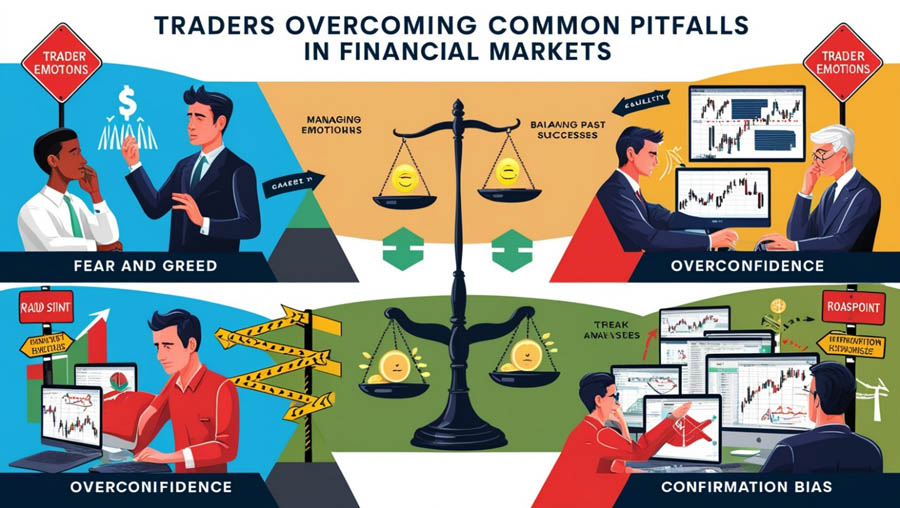In the fast-paced realm of financial markets, achieving lasting success as a trader requires more than just technical acumen and market savvy—it demands a resilient and disciplined mindset. The mindset of a successful trader serves as the cornerstone for effective decision-making, risk management, and navigating the inevitable highs and lows of trading.It encompasses qualities like unwavering discipline, focused attention, patience in waiting for opportune moments, and a commitment to continuous learning and improvement. This guide explores how cultivating these mental attributes not only enhances trading performance but also empowers traders to overcome emotional pitfalls such as fear and greed. Working with a regulated forex broker can further support traders in maintaining confidence and discipline by providing a secure and reliable trading environment.Whether you’re embarking on your trading journey or seeking to refine your approach, understanding and honing the trader’s mindset is fundamental to achieving consistent profitability and long-term success in the competitive world of trading.

The Pillars of a Successful Trader’s Mindset
A successful trader’s mindset is built on several foundational pillars that support consistent and profitable trading. These pillars include discipline and focus, patience and persistence, risk management, and lifelong learning. Each of these elements plays a crucial role in shaping the mindset necessary for long-term success in the trading world.

Discipline and Focus
- Sticking to Your Trading Plan
- Consistency: A trading plan outlines strategies, risk management rules, and goals, fostering discipline and preventing impulsive decisions.
- Commitment: Resist deviations during market volatility to ensure actions align with strategy and objectives.
- Avoiding Impulsive Decisions
- Control: Maintain decision-making control to sustain long-term success, avoiding reactionary moves.
- Analysis: Base decisions on thorough analysis, using technical and fundamental insights.
- Maintaining Emotional Control
- Emotional Resilience: Build resilience for calm and rational decision-making amid market fluctuations.
- Mindfulness: Practice techniques like meditation to manage stress and maintain clarity.
Patience and Persistence
- Waiting for the Right Trading Opportunities
- Timing: Exercise patience for high-probability setups, minimizing risks and maximizing gains.
- Selectivity: Engage selectively in trades with optimal success potential.
- Accepting Losses as Part of the Process
- Realism: Acknowledge losses as inevitable, using them as learning experiences.
- Reflection: Learn from losses to refine strategies and enhance performance.
- Learning from Mistakes and Adapting Strategies
- Growth Mindset: View mistakes as growth opportunities, adapting strategies to evolving market conditions.
- Adaptability: Remain flexible to stay profitable amidst changing markets.
Risk Management
- Understanding and Managing Risk for Each Trade
- Assessment: Evaluate trade risks against overall tolerance levels.
- Balance: Maintain risk-reward balance to protect capital and support growth.
- Utilizing Stop-Loss Orders and Position Sizing Strategies
- Protection: Use stop-loss orders to limit losses and safeguard investments.
- Optimization: Optimize trade size to prevent overexposure and minimize losses.
- Protecting Your Capital for Long-Term Success
- Preservation: Prioritize capital preservation for sustainable trading.
- Sustainability: Focus on long-term growth over short-term gains for consistent profitability.
Lifelong Learning
- Staying Up-to-Date on Market Trends and Analysis Techniques
- Awareness: Stay informed on market trends and analysis for informed decision-making.
- Innovation: Adapt new tools and strategies to enhance trading performance.
- Seeking Continuous Improvement Through Education and Practice
- Commitment to Learning: Invest in education and practice to refine skills and knowledge.
- Practice: Regularly practice and review trades to improve trading techniques.
- Adapting to Changing Market Conditions
- Flexibility: Adjust strategies to meet evolving market conditions.
- Proactivity: Stay proactive in strategy adjustments for continued profitability.
Read More: How to Overcome Greed in Forex Trading ?
Overcoming Common Trading Pitfalls
Navigating the world of trading involves recognizing and overcoming several common pitfalls. These pitfalls can derail even the most well-prepared traders if not managed properly. The primary obstacles include fear and greed, overconfidence, and confirmation bias. By understanding these challenges and employing specific strategies to address them, traders can develop a more resilient and effective mindset.

Fear and Greed
- Recognizing the Emotional Influence of Fear and Greed
- Understanding Emotional Triggers: Fear and greed are the most influential emotions in trading. Fear can manifest as the anxiety of losing money, leading traders to prematurely exit positions or avoid taking trades altogether. On the other hand, greed can push traders to chase after every potential profit, leading to overtrading and taking excessive risks.
- Impact on Decision-Making: Fear can cause paralysis, preventing traders from making necessary decisions. Greed can result in overconfidence, making traders blind to the risks involved. Both emotions can cause traders to deviate from their trading plans, leading to inconsistent and often detrimental results.
- Developing Strategies to Manage These Emotions
- Pre-Trade Preparation: Before entering the market, successful traders prepare meticulously. This involves setting clear entry and exit points, determining acceptable risk levels, and having a contingency plan for unexpected market movements. A well-defined trading plan can act as a safeguard against impulsive decisions driven by fear or greed.
- Mindfulness and Emotional Regulation: Mindfulness techniques, such as meditation, help traders stay calm and focused. Deep breathing exercises can be particularly effective during high-stress moments. Regular practice of these techniques enhances emotional regulation, allowing traders to make decisions based on logic rather than emotion.
- Setting Realistic Expectations: Unrealistic expectations can fuel greed. Traders should aim for consistent, modest gains rather than striving for huge, risky profits. Understanding that losses are a natural part of trading helps keep fear in check and prevents it from influencing decision-making.
- Avoiding Trading Decisions Based on Emotional Impulses
- Strict Adherence to Trading Plan: One of the most effective ways to combat fear and greed is to stick rigidly to a trading plan. This plan should be based on thorough analysis and should outline specific criteria for entering and exiting trades, managing risk, and handling unexpected market conditions.
- Journaling and Self-Reflection: Keeping a trading journal allows traders to track their decisions and the emotions behind them. Reviewing this journal regularly helps identify patterns of behavior driven by fear or greed, facilitating better decision-making in future trades.
Overconfidence
- Recognizing the Dangers of Overconfidence After Successful Trades
- Awareness of Overconfidence Bias: After a series of successful trades, traders might develop an inflated sense of their abilities, leading to overconfidence. This bias can make them underestimate risks and ignore warning signs, increasing the likelihood of significant losses.
- Objective Evaluation of Trades: It is crucial to analyze both successful and unsuccessful trades to maintain objectivity. Understanding the reasons behind each outcome helps traders avoid attributing success solely to their skills and recognize the role of market conditions and other external factors.
- Maintaining a Realistic Perspective on Your Trading Abilities
- Continuous Learning: Overconfidence can be mitigated by acknowledging that there is always more to learn. Successful traders continuously seek to improve their skills through education, mentorship, and staying updated with market trends and new trading strategies.
- Seeking Feedback: Regularly seeking feedback from mentors or peers provides an external perspective on your trading performance. Constructive criticism helps highlight areas for improvement and keeps overconfidence in check.
- Avoiding Excessive Risk-Taking
- Risk Management: Implementing strict risk management rules is essential to prevent excessive risk-taking. This includes setting stop-loss orders, limiting the size of positions relative to your total capital, and adhering to a predefined risk-reward ratio.
- Diversification: Avoid putting all your capital into a single trade or market. Diversifying your investments across different assets or markets can reduce the impact of any single loss and mitigate the effects of overconfidence.
Read More: Risk management principles for both novice and advanced traders
Confirmation Bias
- Understanding the Tendency to Seek Information That Confirms Existing Beliefs
- Definition of Confirmation Bias: Confirmation bias is the tendency to favor information that confirms one’s existing beliefs or hypotheses while disregarding or undervaluing information that contradicts them. In trading, this bias can lead to skewed analysis and poor decision-making.
- Impact on Trading Decisions: Traders influenced by confirmation bias might selectively gather information that supports their views and ignore data suggesting otherwise. This can result in holding onto losing positions for too long or entering trades based on incomplete analysis.
- Seeking Out Diverse Perspectives and Market Analysis
- Broadening Information Sources: To combat confirmation bias, traders should actively seek out diverse perspectives and information sources. This includes reading reports from different analysts, considering alternative viewpoints, and staying open to new data that might challenge their assumptions.
- Critical Thinking: Developing critical thinking skills helps traders evaluate information objectively. Questioning assumptions, analyzing data from multiple angles, and considering the possibility of being wrong can lead to more balanced and informed trading decisions.
- Remaining Objective in Evaluating Trading Opportunities
- Systematic Approach: Adopting a systematic approach to trading can help maintain objectivity. This involves using predefined criteria for evaluating trades, relying on data-driven analysis, and avoiding emotional attachment to any single position or strategy.
- Regular Review: Periodically reviewing your trading strategies and outcomes can help identify instances where confirmation bias may have influenced decisions. This ongoing evaluation supports continuous improvement and helps refine trading approaches.
Developing a Winning Trader Mindset
Developing a winning trader mindset is essential for long-term success in trading. This mindset encompasses setting realistic goals, utilizing visualization techniques, and creating a positive trading routine. By focusing on these elements, traders can build the mental resilience and discipline needed to navigate the complexities of the market.

Setting Realistic Goals
- Establishing Achievable and Measurable Goals
- SMART Goals: Successful traders set SMART goals—specific, measurable, achievable, relevant, and time-bound. These goals provide clear direction and motivation, focusing efforts on achievable targets.
- Short-Term and Long-Term Goals: Balance daily or weekly trading targets with annual returns or portfolio growth objectives. This approach ensures consistent progress and sustains motivation.
- Focusing on Process Over Short-Term Results
- Process-Oriented Mindset: Emphasize disciplined execution, thorough analysis, and consistent risk management over immediate profits. This approach builds sustainable trading habits.
- Incremental Improvements: Focus on continuous small improvements in skills and strategies to achieve significant long-term gains.
- Celebrating Milestones and Learning from Setbacks
- Acknowledging Achievements: Celebrate milestones to reinforce positive habits and maintain motivation.
- Constructive Reflection: Use setbacks as learning opportunities to refine strategies and enhance resilience.
Visualization
- Using Visualization Techniques to Rehearse Successful Trades
- Mental Rehearsal: Visualize successful trades and scenarios to prepare for different market conditions and boost confidence in strategies.
- Positive Imagery: Envision disciplined decision-making and effective risk management to cultivate a success-oriented mindset.
- Building Confidence and Mental Preparedness
- Boosting Self-Confidence: Increase confidence by mentally rehearsing successful outcomes and enhancing trading decisiveness.
- Stress Reduction: Reduce anxiety by mentally preparing for challenges and visualizing appropriate responses.
- Combining Visualization with Solid Trading Strategies
- Integrating Techniques: Combine visualization with well-defined trading strategies, thorough analysis, and disciplined execution for comprehensive success.
- Holistic Approach: Ensure mental preparation aligns with practical strategies, creating a robust framework for trading success.
Developing a Positive Trading Routine
- Creating a Consistent Routine for Studying, Planning, and Executing Trades
- Structured Schedule: Establish a daily routine for studying market trends, planning trades, and executing strategies to foster discipline and readiness.
- Routine Reviews: Regularly adjust the routine by analyzing market conditions and refining strategies to maintain effectiveness.
- Maintaining a Healthy Work-Life Balance
- Prioritizing Self-Care: Allocate time for relaxation, hobbies, and social activities to prevent burnout and maintain focus.
- Preventing Burnout: Take breaks and avoid overtrading to sustain long-term trading success.
- Managing Stress and Promoting Mental Well-Being
- Stress Management Techniques: Use meditation, exercise, and hobbies to reduce stress and maintain a positive mindset.
- Mental Health Support: Seek guidance from mental health professionals or trading communities for additional resources and support.
Advanced Strategies for Mindset Development in Trading
Achieving a resilient and effective trading mindset involves advanced techniques beyond basic principles. Here’s how to enhance your mental approach:

Mindfulness and Meditation for Traders
- Benefits of Mindfulness:
- Enhanced Focus and Concentration: Improves attention span amid market volatility.
- Stress Reduction: Lowers cortisol levels, promoting calm decision-making.
- Improved Emotional Regulation: Manages impulses and maintains emotional balance.
- Incorporating Meditation:
- Start with Short Sessions: Begin gradually and increase duration over time.
- Focus on Breath Awareness: Anchor attention on breath to stay present.
- Consistency: Establish a regular meditation schedule for lasting benefits.
Read More: How to Overcome Fear in Forex Trading
Cognitive Behavioral Techniques (CBT)
- Understanding CBT:
- Principles: Identifies and modifies negative thought patterns and behaviors.
- Thought Restructuring: Challenges irrational beliefs to enhance performance.
- Behavioral Strategies: Uses exposure and desensitization to manage anxiety.
- Applying CBT to Trading:
- Identifying Cognitive Distortions: Recognize and counteract biases like overgeneralization.
- Keeping a Thought Journal: Track thoughts to understand triggers and manage emotions.
- Professional Guidance: Work with a therapist or trading coach for accelerated growth.
Role of Physical Health in Mental Performance
- Nutrition and Exercise:
- Impact of Diet: Balanced nutrition supports cognitive function and stable mood.
- Exercise: Reduces stress, boosts mood, and enhances resilience.
- Sleep Quality: Crucial for cognitive function and decision-making.
- Balancing Physical and Mental Health:
- Integrating Healthy Habits: Combine mindfulness, nutrition, exercise, and sleep for resilience.
- Seeking Professional Guidance: Consult healthcare professionals for personalized plans.
Conclusion
The mindset of a successful trader is built on discipline, focus, patience, persistence, and a commitment to continuous learning. By adhering to a well-defined trading plan, managing emotions, and constantly refining strategies, traders can achieve long-term success. Overcoming common pitfalls such as fear, greed, overconfidence, and confirmation bias is essential for maintaining objectivity and making rational decisions. Developing a winning trader mindset involves setting realistic goals, utilizing visualization techniques, and maintaining a positive trading routine. Ultimately, the journey to becoming a successful trader is an ongoing process that requires dedication, resilience, and a strong mindset.
- What are some effective strategies for managing trading-related stress?
Managing trading-related stress involves incorporating stress-reduction techniques into your daily routine. Practices such as meditation, regular exercise, and engaging in hobbies can help alleviate stress. Additionally, setting clear boundaries between trading and personal time ensures a healthy work-life balance. Implementing proper risk management strategies and sticking to your trading plan can also reduce anxiety, as it minimizes the uncertainty and emotional volatility associated with trading decisions.
- How can I avoid overtrading and maintain discipline?
To avoid overtrading, establish a clear set of rules for entering and exiting trades. Stick to your trading plan and resist the urge to deviate based on short-term market movements. Set specific trading hours and avoid spending excessive time monitoring the markets. Keeping a trading journal can help you track your trades and identify patterns of overtrading, allowing you to make necessary adjustments.
- What role does self-reflection play in developing a successful trader’s mindset?
Self-reflection is crucial for continuous improvement. By regularly reviewing your trades, you can identify strengths, weaknesses, and areas for improvement. Reflecting on both successful and unsuccessful trades helps you understand your decision-making process and emotional responses. This introspection allows you to refine your strategies, avoid repeating mistakes, and build a more resilient mindset.







